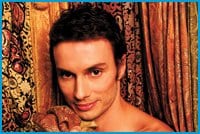The National Ballet Of Canada launches its inaugural season at the new Four Seasons Centre by celebrating a pivotal and glamorous moment in the company’s history. In 1972 the most famous male dancer ever, Rudolph Nureyev, chose the National to stage his lavish version of The Sleeping Beauty. It put the National on the map internationally, taking the young company on an extensive tour throughout North America, including its heralded Met debut in New York in 1973. Filmed for TV in 1974, it won an international Emmy. The company’s most expensive production to date became a glittering showpiece for its roster of rising stars, including Veronica Tennant, Frank Augustyn, Tomas Schramek and Karen Kain.
With The Sleeping Beauty’s $700,000 refurbishment, Kain, now the National’s artistic director, hopes to sprinkle some of that stardust from almost 35 years ago onto the company she took over last year. The Sleeping Beauty, originally choreographed by Marius Petipa with sublime music by Tchaikovsky, is a unique combination of deluxe spectacle and demanding dance that will test the company’s mettle.
While obviously a starring vehicle for the title character, danced by Greta Hodgkinson on opening night opposite Guillaume Côté, The Sleeping Beauty features a string of important solos and dances for a range of characters. It’s no surprise that Nureyev’s version features a much-expanded role for the principal male character, Prince Florimund.
Picking up the princely mantle from Nureyev — though very different in temperment and style — is the National’s veteran principal dancer Aleksandar Antonijevic.
“It’s a honour to dance a ballet of his, obviously, and with this company, especially with its history with Sleeping Beauty,” says Antonijevic, who dances opposite Sonia Rodriguez on the second night performance. “It’s by far the hardest classical ballet out there. Rudolph was known for pushing himself to the absolute limit, adding extra solos and extra steps — the choreography is very intricate.”
With its glittering, ornate costumes (more than 360 in total) and sets restored to the lustre of Nicholas Georgiadis’ original designs, is there a danger the spectacle will overshadow the dance? “The ballet was structured in a way that showcases the principal dancers,” says Antonijevic. “Rudy had a bit of an ego — obviously he wanted himself centre and front, really exposed and really featured in the ballet. Most of the dancing we do in the ballet we do by ourselves on the stage, or we are the only ones moving.
“I personally think it is the best classical ballet. It is so pristine, so clear, clean and minimal, in a way. When it’s done well, exact — the way Karen [Kain] wants it to be done — it’s spectacular to watch.”
Clarity is not really required when it comes to the story of The Sleeping Beauty. We all know the fairy tale: a princess’s christening, a vengeful gatecrasher, a cursed pinprick, the sleeping court and a dashing prince who awakens them all and marries the princess. There’s precious little drama. The romantic leads don’t initiate anything: The princess falls asleep and the prince is led by a fairy to wake her up. Fairyland celebrates. The story’s depth is in the music. Describing it as a “dancing symphony,” Tchaikovsky ranked it among his best. Instead of its shallow narrative, audiences are rewarded more if they focus on what the music is saying, what the gay composer saw as a battle between the forces of fate and life.
“It’s by far the best ballet music Tchaikovsky wrote,” says Antonijevic. “Breathtaking… goose bumps.”
In ballet, all roads lead to St Petersburg (formerly Leningrad) and the Imperial (or Marinsky) Ballet, now known as the Kirov. The Sleeping Beauty premiered there in 1890. After graduating from its school Nureyev made his debut there in 1958 dancing with another graduate Natalia Dudinskaya, the prima ballerina and teacher who would later coach a young Antonijevic in Novi Sad, Serbia. All are devotees of the Vaganova style of dance, a demanding mix of full-body athleticism, agility and expression named after the Kirov’s famous ballet teacher.
“I want to do [the role] perfectly or not at all,” says Antonijevic. “I put a lot of pressure on my self. It’s absolutely the Vaganova style. I was brought up in that style as was Nureyev in Russia…. It’s very familiar for me. I think it sits in my body, I feel comfortable in the style. But it’s such a marathon of a ballet to do.”
A voracious bisexual offstage, Nureyev was known for his animalistic energy onstage, signalling his power in an almost ragged jumping style. Antonijevic’s signature? “Mine would be the complete opposite,” he says. “Restrained, understated and hopefully pristine. The way I was brought up was that you don’t show the physical effort. Some people like that about me and my dancing and some people don’t. I can’t try and be Nureyev. I do the steps the way that I see them; they have to be true to myself.”
If Nureyev is an inspiring rather than oppressive presence, how does the 37-year-old Antonijevic, in his 15th year with the company, feel about a new principal dancer with star power, 27-year-old Zdenek Konvalina, who arrived this season from the Houston Ballet? He’ll debut as the prince on Sun, Nov 12. Does his presence make Antonijevic competitive?
“If you asked me that 10 years ago I would’ve said…,” Antonijevic growls and starts to laugh, “Ya.
“Now, I’m blown away by the type of dancer he is and how spectacular he is, his God-given talent. It’s really wonderful to watch the ease with which he can do really breathtaking technical steps. So I think it’s a great thing for the company to have him.”
At this stage in his career, Antonijevic readily acknowledges he often wonders when to retire. Constant injuries and the effort to recover take a terrible toll. It’s an awful choice for a dancer to make and one Antonijevic observed firsthand. Antonijevic has been in a relationship with former principal dancer Geon van der Wyst for five years. On the eve of his own appearance in The Sleeping Beauty in 2004, van der Wyst called it quits after the pain from injuries became too much. He’s now a real estate agent.
“I’m so proud of him,” says Antonijevic. “The way he went through that is just unbelievable — so together, so looking forward to the next day, the next step, the life that is still in front of him. He was amazing to watch him go through that transformation with such calm and dignity.
“But I do miss him, those six hours being around each other in the studio, seeing each other in the corridor. It’s definitely different now. You just try to make the most of the moments we have together.”
Years ago when interviewed for this magazine, Antonijevic was reticent to talk about his sexuality. Though still a very private individual, that reticence is gone. What changed?
“What changed was that I met someone I really wanted to share my life with. That’s the way it is. It changes you completely. When it happens to you, it becomes a nonissue.”


 Why you can trust Xtra
Why you can trust Xtra


